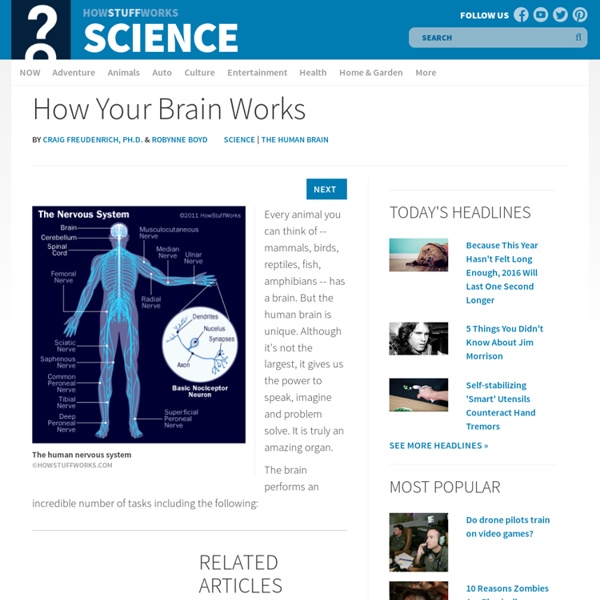Work In Progress - Adolescent Brains Are A Work In Progress
FRONTLINE's "Inside the Teenage Brain" focuses on work done by Dr. Jay Giedd at the National Institute of Mental Health in Bethesda, Md., together with colleagues at McGill University in Montreal. In a particularly interesting study, Dr.
Your Amazing Brain
You carry around a three-pound mass of wrinkly material in your head that controls every single thing you will ever do. From enabling you to think, learn, create, and feel emotions to controlling every blink, breath, and heartbeat—this fantastic control center is your brain. It is a structure so amazing that a famous scientist once called it "the most complex thing we have yet discovered in our universe." Your brain is faster and more powerful than a supercomputer. Your kitten is on the kitchen counter. She's about to step onto a hot stove.
What About The Mind? Mind Relaxation Techniques - Foundation For Well Being
Article # 4: What about the Mind? Part I I am drawing a distinction here between the brain and the Mind, between the Mind and the mind. The brain is a physical thing, encased within the physical body.
FCS2241/FY769: Helping Teens Answer the Question ?Who Am I??: Cognitive ...
This publication is the second of a series that explores adolescence in terms of physical, cognitive, social, and moral development. This publication will focus on the cognitive development that adolescents experience. The journey from childhood to adolescence is very challenging. Between the ages of 10 and 18 there are major changes in physical, cognitive, social, and moral development. The major task for adolescents is to establish their self-identity. By determining—as best they can—a sense of who they are, they attempt to move into a group that reflects or reinforces this self-identity.
THE BRAIN FROM TOP TO BOTTOM
A presynaptic neuron has several specialized structures that distinguish it from a postsynaptic neuron. The terminal button of the presynaptic neuron’s axon contains mitochondria as well as microtubules that transport the neurotransmitters from the cell body (where they are produced) to the tip of the axon. (click on 2. Axonal Transport) This terminal button also contains spherical vesicles filled with neurotransmitters.
The Brain and Senses
Welcome to the Brain and Senses! Hi, we are Dr Ellen Poliakoff and Dr Luke Jones and we’re experimental psychologists. This means that we find out how people think and how the brain works. When we are not teaching - or lecturing as it's called at University! - we can be found doing experiments in the laboratory. Ellen is finding out about how we move and Luke is doing experiments about how we understand time.
How the Brain Learns Best
Easy ways to gain optimal learning in the classroom by activating different parts of the brain By Bruce D. Perry, M.D., Ph.D. Over the last 40 years we have learned more about the human brain than in the previous 400 years. Educators and neuroscientists have been trying to put this knowledge to work by transforming the information of basic and clinical neurosciences into practical insights for the classroom. In a series of special features, we will be looking at how the brain works and what this can tell us about your teaching.
The Central Nervous System
The central nervous system is made up of the The spinal cord conducts sensory information from the peripheral nervous system (both somatic and autonomic) to the brain conducts motor information from the brain to our various effectors serves as a minor reflex center
Content Development
We have known since antiquity that the seat of learning is the human brain. But it has only been in the last decade that neuroscience researchers have been able to go inside the brain and observe how learning actually occurs at the molecular level. New technologies like diffusion imaging have opened up the brain's inner workings and allowed scientists to "see" what is going on inside the brain when people are engaged in learning. More sophisticated experiments with the brains of laboratory animals are stretching the bounds of our understanding further. To comprehend the way learning occurs in the brain, here’s a brief primer on its physiology. The brain acts as a dense network of fiber pathways consisting of approximately 100 billion (1010) neurons.
Explore the nervous system
divisions of the nervous system table of contents Neuroanatomy: the structure of the nervous system.
How Human Memory Works"
The more you know about your memory, the better you'll understand how you can improve it. Here's a basic overview of how your memory works and how aging affects your ability to remember. Your baby's first cry...the taste of your grandmother's molasses cookies...the scent of an ocean breeze. These are memories that make up the ongoing experience of your life -- they provide you with a sense of self.
Comparative Neuroanatomy and Intelligence
Have you ever wondered what makes us humans different from, say, a rat? Have you ever wanted to see a cerebellum up close and personal? Have you ever looked at a frog and thought to yourself - hmmm, I wonder if he has neocortex? Have you ever wondered how intelligence is defined? If so (or even if not!), you have come to the right place.
Brain Connection » Powered by Posit Science - Your Brain Health Headquarters
I remember my mother’s vegetable garden when I was a child, corn plants tall like skyscrapers. I remember when I fell out of a tree and everyone from the neighbor’s barbecue rushed over to see if I’d broken a bone. Remember, remember… the verb itself is poetic, connotating the essence of experience.




Gran hallazgo!!!! Gracias a esta página irás recordando TODO sobre Neurociencia! Sí, sé que hace un año esto hubiera sido la bomba, pero... "nunca es tarde si la dicha es buena"!! Te servirá para recordar y pasarlo a los campis de Primero!! ¿A qué esperas? by saglez19 May 14